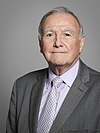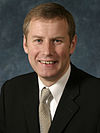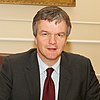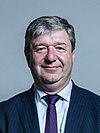Scottish Liberal Democrats
This article needs additional citations for verification. (June 2018) |
Scottish Liberal Democrats Pàrtaidh Libearal Deamocratach na h-Alba | |
|---|---|
 | |
| Leader | Alex Cole-Hamilton |
| Deputy Leader | Alistair Carmichael |
| President | Willie Wilson |
| Founded | 8 March 1988 |
| Headquarters | 4 Clifton Terrace Edinburgh EH12 5DR[1] |
| Youth wing | Scottish Young Liberals |
| Membership (Dec. 2019) | |
| Ideology | |
| Political position | Centre to centre-left |
| National affiliation | Liberal Democrats |
| European affiliation | Alliance of Liberals and Democrats for Europe |
| International affiliation | Liberal International |
| Colours | Yellow[9] |
| Slogan | "Put Recovery First" |
| Scottish seats in the House of Commons | 4 / 59 |
| Scottish Parliament | 4 / 129 |
| Local government in Scotland | 67 / 1,227 |
| Website | |
| www | |
| |
The Scottish Liberal Democrats (Scottish Gaelic: Pàrtaidh Libearal Deamocratach na h-Alba, Scots: Scots Leeberal Democrats) is a liberal, federalist political party in Scotland, a part of the United Kingdom Liberal Democrats. The party currently holds 4 of the 129 seats in the Scottish Parliament and 4 of the 59 Scottish seats in the UK House of Commons.
The Scottish Liberal Democrats is one of the three state parties[10] within the federal[11] Liberal Democrats, the others being the Welsh Liberal Democrats and the English Liberal Democrats. The Liberal Democrats do not contest elections in Northern Ireland.
Leaders[]
| No. | Image | Name | Term start | Term end |
|---|---|---|---|---|
| 1 |  |
Malcolm Bruce | 3 March 1988 | 18 April 1992 |
| 2 |  |
Jim Wallace | 18 April 1992 | 23 June 2005 |
| 3 |  |
Nicol Stephen | 23 June 2005 | 2 July 2008 |
| Acting |  |
Michael Moore | 2 July 2008 | 26 August 2008 |
| 4 |  |
Tavish Scott | 26 August 2008 | 7 May 2011 |
| 5 |  |
Willie Rennie | 17 May 2011 | 20 July 2021 |
| Acting |  |
Alistair Carmichael | 20 July 2021 | 20 August 2021 |
| 6 |  |
Alex Cole-Hamilton | 20 August 2021 | Incumbent |
Deputy Leaders[]
| No. | Image | Name | Term start | Term end |
|---|---|---|---|---|
| 1 |  |
Michael Moore | 2 November 2002 | 20 September 2010 |
| 2 |  |
Jo Swinson | 20 September 2010 | 23 September 2012 |
| 3 |  |
Alistair Carmichael | 23 September 2012 | Incumbent |
Structure[]
In keeping with its basis as a federation of organisations, the Scottish party also consists of a number of local parties (which mostly follow the boundaries of the Scottish Council Areas), which are each distinct accounting units under the Political Parties, Elections and Referendums Act 2000. Local parties are predominantly responsible for the party's political campaigning and for selecting candidates for parliamentary and local authority elections.
There are also eight regional parties (based on the boundaries of the eight Scottish Parliament electoral regions).
Administration[]
The party's headquarters are located in Edinburgh.
The conference is the highest decision-making body of the party on both policy and strategic issues. The day-to-day organisation of the party is the responsibility of the party's Executive Committee, which is chaired by the Convener of the party and includes the Leader, the Depute Leader and the President of the party, as well as the party Treasurer and the three Vice-Conveners. See below for the current office-bearers and all other members of the Party's three management committees (Executive Committee, Policy Committee and Conference Committee). All party members vote every two years in internal elections to elect people to all the below positions, except Leader & Depute Leader.
Current party leadership, office bearers and committee members[]
- Leader: Alex Cole-Hamilton MSP
- Depute Leader: Alistair Carmichael MP
- Convener: Sheila Ritchie
- Treasurer: Steve Arrundale
- President: Cllr Willie Wilson
- Vice-Convener, Policy: Carole Ford
- Vice-Convener, Conference: Paul McGarry
- Vice-Convener, Campaigns & Candidates: Alan Reid
Scottish headquarters staff[]
This section does not cite any sources. (December 2019) |
The party employs a small team of staff at their HQ in Edinburgh.
Conferences[]
Like the Federal party, the Scottish party holds two conferences per year; a Spring Conference, and an Autumn Conference.
Associated organisations[]
Associated organisations generally seek to influence the direction of the party on a specific issue or represent a section of the party membership. The party has five associated organisations:
- Association of Scottish Liberal Democrat Councillors and Campaigners (ASLDC)
- LGBT+ Liberal Democrats
- Scottish Green Liberal Democrats
- Scottish Women Liberal Democrats
- Scottish Young Liberals
Association of Scottish Liberal Democrat Councillors and Campaigners[]
The Association of Scottish Liberal Democrat Councillors (ASLDC)[12] is a network of Liberal Democrat councillors and local campaigners across Scotland which works to support and develop Liberal Democrat involvement in Scottish Local Government.
Following the Local Council Election of May 2017, under the Single Transferable Vote (STV) system, 67 Liberal Democrats were elected, a drop of 3 on Local Council Election of May 2012.
A voluntary Executive Committee meets several times a year to run the organisation.
ASLDC works alongside Liberal Democrats in the Convention of Scottish Local Authorities (CoSLA) where Cllr Peter Barrett is leader of the Lib Dem Group.
History[]
The Scottish Liberal Democrat party was formed by the merger of the Scottish Liberal Party and the Social Democratic Party (SDP) in Scotland, as part of the merger of the Liberal Party and SDP on 3 March 1988.[13]
The party campaigned for the creation of a devolved Scottish Parliament as part of its wider policy of a federal United Kingdom. In the late 1980s and 1990s it and its representatives participated in the Scottish Constitutional Convention with the Scottish Labour Party, Scottish Green Party, trades unions and churches, and also campaigned for a "Yes-Yes" vote in the 1997 devolution referendum.
1999–2007: Coalition government with Labour[]
In the first elections to the Scottish Parliament in 1999, the party won 17 seats. Following this, the party formed a coalition government with Scottish Labour in the Scottish Executive. The then party leader, Jim Wallace, became Deputy First Minister of Scotland and Minister for Justice. He also served as acting First Minister on three occasions, during the illness and then later, the death of the first First Minister Donald Dewar and the following resignation of his successor Henry McLeish. This partnership was renewed in 2003 and Wallace became Deputy First Minister and Minister for Enterprise and Lifelong Learning. On 23 June 2005, Nicol Stephen MSP succeeded Wallace as party leader and took over his positions in the Executive until the 2007 elections.
Prior to the partnership government being formed in 1999, the UK had only limited experience of coalition government. The party's participation attracted criticism for involving compromises to its preferred policies, although several of its manifesto pledges were adopted as government policy or legislation. These included changes to the arrangements for student contributions to higher education costs (although whether that amounted to the claimed achievement of having abolished tuition fees was hotly contested), free personal care for the elderly and (during the second coalition government) changing the system of elections for Scottish local authorities to the single transferable vote, a long-standing Liberal Democrat policy.
2007–present: Opposition and electoral decline[]
In the 2007 Scottish Parliament election, the party won one fewer seat than in the two previous Scottish elections: this was the first parliamentary election for 28 years in which the party's parliamentary strength in Scotland was reduced. This experience led to some criticism of the party's election strategy and its leader. Although it was arithmetically possible to form a majority coalition with the Scottish National Party and the Scottish Green Party, the party refused to participate in coalition negotiations because of a disagreement over the SNP's policy of a referendum on Scottish independence, and sat as an opposition party in the Parliament.
On 2 July 2008, Nicol Stephen resigned as the party leader. The former deputy leader Michael Moore MP served as acting leader of the party until Tavish Scott MSP was elected party leader on 26 August 2008, winning 59% of the votes cast in a contest with parliamentary colleagues Ross Finnie and Mike Rumbles. (See also 2008 Scottish Liberal Democrats leadership election.)
At the 2011 Scottish Parliament election, the party lost all its mainland constituencies, retaining only the two constituencies of Orkney and Shetland. It also secured three List MSPs. This was, at the time, by far the party's worst electoral performance since the re-establishment of a Scottish parliament in 1999. At the 2014 European Parliament election, the party lost its only MEP.
At the 2015 general election, the party lost 10 of its 11 MPs with only Alistair Carmichael narrowly retaining Orkney and Shetland with a 3.6% majority.
At the 2016 Scottish Parliament election, the party again had 5 MSPs elected but was pushed into 5th place by the Scottish Greens. While it gained the 2 constituency seats of Edinburgh Western and North East Fife from the SNP, its vote share fell slightly overall.
At the 2017 general election, the party retained Orkney and Shetland with an increased majority, as well as gaining back three seats lost to the SNP in 2015 – Caithness, Sutherland and Easter Ross, East Dunbartonshire and Edinburgh West. The Scottish Liberal Democrats lost out on the North East Fife constituency to Stephen Gethins of the SNP by just two votes- making it the most marginal result in the UK at the general election that year.
Two years later, at the 2019 general election, UK leader Jo Swinson lost East Dunbartonshire to Amy Callaghan of the SNP by 150 votes, and was forced to stand down as leader; but the Liberal Democrats were successful in defeating the SNP at North East Fife and retained four seats in Scotland. The Scottish Lib Dems replaced Scottish Labour as the third-largest party in Scotland, in terms of seats, at the 2019 general election, in a historical landslide defeat for the party nationwide.[14][15]
At the 2021 Scottish Parliament election, only 4 MSPs were elected for the party, holding onto their 4 constituency seats while losing their single regional seat in North East Scotland. The party's vote share also declined further, reaching a new low in both constituency and list vote share at a Scottish Parliamentary election, and 50 deposits were lost out of the 73 constituencies contested. The result meant the party is no longer recognised as a parliamentary party in the Scottish Parliament due to the threshold being five, and so they lost certain parliamentary rights such as a guaranteed question at First Ministers Questions.
Policy platform[]
The Scottish Party decides its policy on state matters independently from the federal party. State matters include not only currently devolved issues but also those reserved matters which the party considers should be devolved to the Scottish Parliament, including broadcasting, energy, drugs and abortion.[16] The party also believes that the Scottish Parliament should exercise greater responsibility on fiscal matters. A party commission chaired by former Liberal Party leader and Scottish Parliament Presiding Officer Sir David Steel set out the party's proposals on the constitutional issue.[17]
According to its constitution, the party believes in a "fair, free and open society ... in which no-one shall be enslaved by poverty, ignorance or conformity". It has traditionally argued for both positive and negative liberties, tolerance of social diversity, decentralisation of political authority, including proportional representation for public elections, internationalism and greater involvement in the European Union. In the 2007 elections it campaigned for reforms to public services and local taxation, and for more powers for the Scottish Parliament within a federal Britain.
In December 2007, the party (along with Scottish Labour and the Scottish Conservatives) supported the creation of a new Commission on Scottish Devolution, along similar lines to the earlier Scottish Constitutional Convention, to discuss further powers for the Scottish Parliament.
In 2012, the Scottish Liberal Democrats joined the Better Together campaign with other Unionist political parties to campaign for a No vote in the 2014 Independence Referendum, with Craig Harrow, then convener of the party, joining the Board of Directors.
Elected representatives (current)[]
Scottish Parliament[]
| Member of the Scottish Parliament | Constituency or Region | First elected | Spokespersons[18] |
|---|---|---|---|
| Willie Rennie | North East Fife | 2011 | |
| Liam McArthur | Orkney | 2007 | Justice and Energy |
| Beatrice Wishart | Shetland | 2019 | Education |
| Alex Cole-Hamilton | Edinburgh Western | 2016 | Leader of the Scottish Liberal Democrats |
House of Commons of the United Kingdom[]
| Member of Parliament | Constituency | First elected | Notes |
|---|---|---|---|
| Alistair Carmichael | Orkney and Shetland | 2001 | Only Lib Dem MP returned in the 2015 general election in Scotland. |
| Christine Jardine | Edinburgh West | 2017 | |
| Jamie Stone | Caithness, Sutherland and Easter Ross | 2017 | Member of the Scottish Parliament for Caithness, Sutherland and Easter Ross between 1999 and 2011. |
| Wendy Chamberlain | North East Fife | 2019 |
Only gain made by the Liberal Democrats in Scotland at the 2019 general election. Was previously the most marginal seat in the entire United Kingdom in 2017. |
Electoral performance[]
Scottish Parliament[]
| Election | Constituency | Regional | Total seats | +/– | Rank | Government | ||||
|---|---|---|---|---|---|---|---|---|---|---|
| Votes | % | Seats | Votes | % | Seats | |||||
| 1999 | 333,179 | 14.2 | 12 / 73
|
290,760 | 12.4 | 5 / 56
|
17 / 129
|
4th | Lab–LD | |
| 2003 | 294,347 | 15.4 | 13 / 73
|
225,774 | 11.8 | 4 / 56
|
17 / 129
|
4th | Lab–LD | |
| 2007 | 326,232 | 16.2 | 11 / 73
|
230,651 | 11.3 | 5 / 56
|
16 / 129
|
4th | Opposition | |
| 2011 | 157,714 | 7.9 | 2 / 73
|
104,472 | 5.2 | 3 / 56
|
5 / 129
|
4th | Opposition | |
| 2016 | 178,238 | 7.8 | 4 / 73
|
119,284 | 5.2 | 1 / 56
|
5 / 129
|
5th | Opposition | |
| 2021 | 187,816 | 6.9 | 4 / 73
|
137,152 | 5.1 | 0 / 56
|
4 / 129
|
5th | Opposition | |
House of Commons[]
This chart shows the electoral results of the Scottish Liberal Democrats, from the first election the party contested in 1992. Total number of seats, and vote percentage, is for Scotland only. For results prior to 1992, see Scottish Liberal Party.
| Election | Scotland | +/– | Government | |
|---|---|---|---|---|
| % | Seats | |||
| 1992 | 13.1 | 9 / 72
|
Opposition | |
| 1997 | 13.0 | 10 / 72
|
Opposition | |
| 2001 | 16.3 | 10 / 72
|
Opposition | |
| 2005 | 22.6 | 11 / 59
|
Opposition | |
| 2010 | 18.9 | 11 / 59
|
Cons–LD | |
| 2015 | 7.5 | 1 / 59
|
Opposition | |
| 2017 | 6.8 | 4 / 59
|
Opposition | |
| 2019 | 9.0 | 4 / 59
|
Opposition | |
European Parliament[]
| Election | Scotland | +/– | ||||
|---|---|---|---|---|---|---|
| Votes | % | Seats | ||||
| 1994 | 7.2 | 0 / 8
|
||||
| 1999 | 96,971 | 9.8 | 1 / 8
|
|||
| 2004 | 154,178 | 13.1 | 1 / 7
|
|||
| 2009 | 127,038 | 11.5 | 1 / 6
|
|||
| 2014 | 95,319 | 7.1 | 0 / 6
|
|||
| 2019 | 218,285 | 13.8 | 1 / 6
|
|||
Liberal Democrat Scottish peers in the House of Lords[]
| Peer | Ennobled | Notes |
|---|---|---|
| Patrick Boyle, 10th Earl of Glasgow | 1984 | Current chief of Clan Boyle |
| Elizabeth Barker, Baroness Barker | 1999 | |
| Malcolm Bruce, Baron Bruce of Bennachie | 2015 | |
| Menzies Campbell, Baron Campbell of Pittenweem | 2015 | |
| James Erskine, 14th Earl of Mar | 2000 | |
| Archy Kirkwood, Baron Kirkwood of Kirkhope | 2005 | MP for Roxburgh and Berwickshire from 1983 to 2005 |
| Jeremy Purvis, Baron Purvis of Tweed | 2013 | MSP for Tweeddale, Ettrick and Lauderdale (2003 to 2011) |
| David Steel, Baron Steel of Aikwood | 1997 | Leader of the Liberal Party & Leader of the Social and Liberal Democrats (1976 to 1988) |
| Nicol Stephen, Baron Stephen | 2011 | Leader of the Scottish Liberal Democrats (2005 to 2008) |
| Alison Suttie, Baroness Suttie | 2013 | Deputy chief of staff to Deputy Prime Minister Nick Clegg (2010 to 2011) |
| John Sinclair, 3rd Viscount Thurso | 2016 | |
| Iain Vallance, Baron Vallance of Tummel | 2004 | |
| Jim Wallace, Baron Wallace of Tankerness | 2007 | Leader of the Scottish Liberal Democrats (1992 to 2005) |
See also[]
References[]
- ^ "Scottish Liberal Democrat HQ". Scottish Liberal Democrats. Retrieved 10 November 2019.
- ^ "Scottish Liberal Democrats Annual Report and Financial Statements". Electoral Commission.
- ^ Eve Hepburn (2010). Using Europe: Territorial Party Strategies in a Multi-level System. Oxford University Press. p. 228. ISBN 978-0-7190-8138-5.
- ^ Jump up to: a b Nordsieck, Wolfram (2016). "Scotland/UK". Retrieved 1 October 2018.
- ^ Helma Gerritje Engelien de Vries (2007). Insiders and Outsiders: Global Social Movements, Party Politics, and Democracy in Europe and North America. ProQuest. p. 208. ISBN 978-0-549-45223-2.
- ^ http://www.libdems.org.uk/ (4 October 2013). "F41: Towards a Federal UK". libdems.org.uk.
- ^ http://www.libdems.org.uk/ (6 March 2017). "Scot Lib Dems launch Federalism drive". scotlibdems.org.uk.
- ^ Foster, Greg (8 March 2016). "Where do the Scottish Lib Dems stand on independence?". Scottish Liberal Democrats. Retrieved 15 November 2016.
- ^ "Style guide". Liberal Democrats. 23 March 2017. Retrieved 5 February 2018.
- ^ "The party is led by Scotland's Deputy First Minister Nicol Stephen MSP and is a state party within the Liberal Democrats", scotlibdems.org.uk, accessed 23 September 2006 (Archived 2 October 2006 at the Wayback Machine)
- ^ "Party Structure" Archived 2 October 2006 at the Wayback Machine, scotlibdems.org.uk
- ^ "Scotland and ASLDC – Association of Liberal Democrat Councillors". aldc.org.
- ^ "Liberal Democrat History Group". Liberalhistory.org.uk. Archived from the original on 29 August 2014. Retrieved 7 May 2011.
- ^ "Results of the 2019 General Election in Scotland". BBC News.
- ^ "Scottish Lib Dem MPs meet after leader loses seat". 14 December 2019.
- ^ "Scottish policy responsibilities include all devolved matters plus matters that we believe should be the responsibility of the Scottish Parliament." Archived 2 October 2006 at the Wayback Machine, scotlibdems.org.uk
- ^ "Microsoft Word - Steel Commission Report March 2006 formatted.doc" (PDF). Archived from the original (PDF) on 13 November 2013. Retrieved 7 May 2011.
- ^ "Labour and Lib Dems reveal detail of reshuffles". scotsman.com.
External links[]
| Wikimedia Commons has media related to Scottish Liberal Democrats. |
- Scottish Liberal Democrats
- Liberal Democrats (UK)
- 1988 establishments in Scotland
- Liberal parties in the United Kingdom
- Organisation of the Liberal Democrats (UK)
- Organisations based in Edinburgh
- Political parties established in 1988